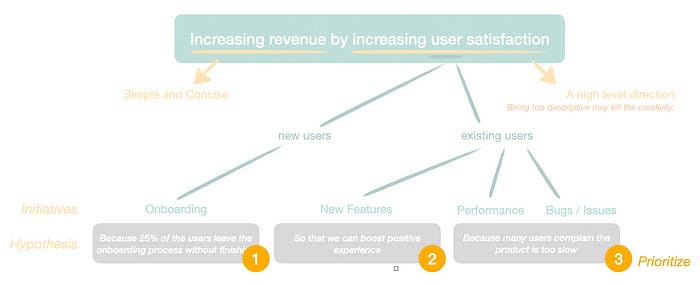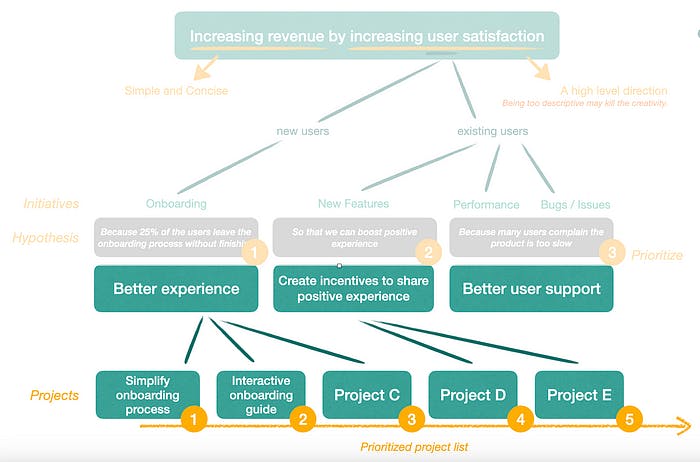What I Learned about “Product Roadmap” from Stanford Product Management Accelerated Program
Getting from Company Strategies to Product Roadmap

Decomposing a company strategy into a product roadmap.
I’m recently taking the online Stanford program Product Management: Accelerated Program. One of the lectures I found very helpful for product managers is about how we derive a product roadmap from company-level strategies and product strategies. Whether you’re a seasoned product manager or just starting out in the field, this article has something for you. Here we go!
Objectives come before strategies
Before creating a product roadmap, we must first have a product strategy. Before having product strategies, we must first identify the objectives.
A strategy is a series of actions organized to achieve a specific objective.
While this may seem simple, it is not always easy to achieve in the workplace. Before proposing a solution, we must know what problem we are trying to solve. Otherwise, we may be stuck and don’t know if the project is making progress or addressing the real problem.
Objectives
The key to setting objectives is “simple and concise” so everyone can quickly grasp the main ideas. In companies, it is usually the CEO or C-suite executives who set the overall objectives. These objectives may include increasing revenue, improving customer satisfaction, increasing customer retention, and so on, and achieving these objectives often requires the efforts of multiple departments.
Company strategies come before product strategies
A key concept from the Stanford Product Accelerated program is decomposing the company strategy to establish a product strategy. The following sentence is a quote from the course:
“In order to have a product strategy, you MUST start with a company strategy to set the objectives!”
The company must have clear objectives and a clear priority order. If you want to create a product roadmap but the company strategy is not yet clear, put the roadmap aside and first consult your manager about what they think about the company strategy!
Decompose the company strategy
After analyzing the company strategy, we can begin to break it down into product strategies. Here, we will break down the product strategy step by step with examples.

Step 1, Identify the 3–5 most relevant company strategies, by Jean Huang
Step 1: Identify the 3 to 5 most relevant company strategies.
The first step for a product manager is to identify the three to five most relevant company strategies related to “product.” For example, one of the most relevant company strategies may be “increasing revenue by increasing customer satisfaction.” (Note, this sentence expresses the company strategy clearly and concisely.)
Note that we focus on 3 to 5 items here because if we consider all items, we won’t be able to do anything. We must prioritize.
Step 2, Divide each strategy into 3 to 5 sub-items, by Jean Huang
Step 2: Divide each strategy into 3 to 5 sub-items
Next, as a product manager, we can consider, “What are the different angles we can approach for ‘increasing customer satisfaction’?”
Users → New users
- Onboarding: The experience and process of introducing new users to the product.
Users → Existing users → To make users happy → Smooth experience
- Bugs/Issues: Known issues — If there are too many problems, users may switch to other alternatives.
- Performance: Product efficiency — If the product is too slow, people may get frustrated and leave.
Users → Existing users → To make users happy → Solve users’ pain points
- New Feature Requests: Think about “what features do customers really want? Will adding new features make customers happier?
Of course, there is no fixed formula for breaking down a concept into multiple sub-items. (It is not just limited to onboarding, bugs/issues, performance, and new feature requests). The key is to practice breaking down big concepts into actionable items.
Here’s a great method for breaking down concepts:
Mutually Exclusive, Collectively Exhaustive (MECE), a framework from McKinsey that helps us break down complex problems into smaller ones.
- Mutually Exclusive: Are all the small subsets we break down overlapping with each other? Asking this question avoids us from looking at the same problem from different perspectives.
- Collectively Exhaustive: Is the sum of these small subsets the original big problem we started with?
MECE is a helpful tool to break down company strategies into product strategies. However, it doesn’t necessarily have to be 100% MECE. It’s worth noting that when breaking down problems, we need to be mindful and logical. For example, we can break down onboarding into two parts: (1) the first half of onboarding and (2) the second half of onboarding. (1) and (2) are mutually exclusive, and the sum is a complete onboarding. However, because the breakdown method is illogical, it is almost impossible to execute. In the world of products, we can think about whether (1) and (2) can operate independently as two different teams within the company. If not, this may not be a good breakdown method.

Step 3, Write the hypothesis for each subtopic (initiative), by Jean Huang
Step 3: Write the hypothesis for each subtopic (initiative)
When we break down the main topic into multiple subtopics (Initiatives), we are not doing it just for the sake of breaking it down, but to clearly understand the reasons for doing so and how they can help achieve the company goal. For example, the Performance issue mentioned earlier can respond to the company strategy of increasing revenue by increasing customer satisfaction. If the software is too slow, improving performance can increase customer satisfaction and, in turn, increase revenue.

Step 4, Prioritize, by Jean Huang
Step 4: Prioritize
After establishing the four aspects, we can use qualitative or quantitative analysis (Fermi estimation, customer feedback, even common sense, etc.) to prioritize them. For example, if 75% of users feel that the onboarding experience is poor but no one mentions issues with performance or bugs, we should prioritize onboarding as the first item.

Step 5, Develop a product strategy, by Jean Huang
Step 5: Develop a product strategy
After the above steps, we create a list of product strategies (Initiatives). We may not be sure if we need to execute all of them, but this has laid a good foundation for our next steps.
- Onboarding: Improve the new user experience
- New feature: Create incentives for satisfied users to share their experiences
- Bugs/Issues, Performance: Improve customer service experience

Step 6, Develop a product roadmap
Step 6: Develop a product roadmap
Finally, we arrive at this step! From the list of strategies above, we can develop a product roadmap! The following is quoted from Stanford Product Management Accelerated:
A roadmap is a living document that communicates a prioritized list of projects to achieve the product strategy.
- Product Strategy: What do we want to do (What?)
- Product Roadmap: How do we achieve it (How?) When do we achieve it (When?)
Developing a product roadmap from product strategies requires further decomposition, and we must ensure that the product roadmap has the following three characteristics:
- Living: Product managers can adjust it regularly, the organization must have clear processes, everyone knows when / how often the product roadmap will be updated, and how to provide feedback.
- Prioritized: Projects must have priority and reasons behind them.
- Projects: They can be big or small and should not be limited to just features.
Many companies may first create a product roadmap and then list product strategies from it, which is actually working in reverse and not recommended.
I have summarized the 6 steps in the following diagram. Hopefully,it helps to visualize the decomposition process.

Decomposing a company strategy into a product roadmap, by Jean Huang
